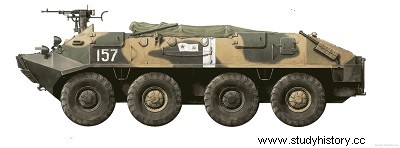
BTR-60P, BTR-60PK, BTR-60PB, BTR-60PU, BTR60PB (FAC)
Type :armored personnel carrier.
Crew :2 + 14 men.
Armament :a 14.5 mm KPVT machine gun; a 7.62 mm PKT machine gun paired with the previous
Armour :14mm.
Dimensions:
length :7.56 m;
width :2.82 m;
height (turret included):2.31 m.
Weight in combat order: 10.3 t
Engine: 2 GAZ-49B 6 cyl. in-line gasoline engine, each developing 91 hp at 3,400 rpm.
Performance:
road speed speed:80 km/h;
speed on water: 10 km/h;
range: 500 km;
vertical obstacle :0.40 m;
clean cut :2 m;
slope: 60%.
Service time :introduced in 1961. Used by Afghanistan, Algeria, East Germany Angola, Bulgaria, North Korea, Cuba, Egypt, Hungary, Iran, Iraq Israel, Libya, Mongolia, Poland, Romania, Syria, Soviet Union, North Yemen, Yugoslavia. Production is believed to have ended in the early 1970s (Note:This data is for the BTR60PB.)
The BTR-60P series was introduced in 1960-61 to replace the BTR-152 which, based on a standard truck chassis, had poor off-road performance. The BTR-60 is used mainly in motorized infantry divisions, tank divisions being equipped with BMP-1 tracked vehicles. Mounted on wheels, the BTR-60 has a higher road speed than a tracked vehicle and therefore greater strategic (rather than tactical) mobility.
The designation ' TR-60P breaks down as follows:BTR stands for 'Brone TRansporter' (armored personnel carrier), 60 indicates the year of introduction and P is the initial of 'Plavayushchiy' (amphibious).
The P is also used in the name of other Soviet vehicles, such as the PT76 tank. The BTR-60P has eight road wheels, all-wheel drive (8x8), steering, assisted to reduce driver fatigue, acting on the four front wheels Tire pressure is set by central control, which allows the driver to 'adapt the ground pressure to the nature of the terrain.
The BTR-60P, which has excellent amphibious qualities, is propelled on the water by a hydro-reactor located at the rear of the cash register. It is used by both marines and infantrymen. Her standard equipment includes infrared lighting and electric bilge pumps.
Some vehicles have a winch mounted inside and at the front to facilitate self-recovery operations.
The first model put into service was the BTR -60P. As in all later vehicles, its driver and commander sit at the very front of the hull.
However, its roof is open and the infantrymen are seated on benches arranged transversely. They are very exposed to shrapnel and must wear special clothing to cross an NBC environment. Small doors and firing hatches are fitted on either side of the hull. This model is normally armed with one DShK 12.7mm machine gun and up to three pintle-mounted 7.62mm SGMB or PKT machine guns.
The next model is the BTR-60PK, whose troop compartment is completely closed and provided with an NBC system. Access to the vehicle is through hatches in the roof There are firing hatches in the hull sides and normally the vehicle is armed with one DShK machine gun and two 7.62mm SGBM or PKT machine guns . Like those of the BTR-60P, the machine guns of the BTR-60PK have no shields and their crews are therefore very vulnerable to small arms fire.
The latest model put into service is the BTR-60PB. Almost identical to the BTR-60Pk, it however has the same turret as the BRDM-2 reconnaissance vehicle (4x4). It
is armed with a 14.5mm PKVT heavy machine gun and a coaxial 7.62mm PKT machine gun, both offering +30° to -5 elevation fire ° and in 360° azimuth.
The ammunition load is 500 cartridges of 14.5 mm and 2,000 of 7.62 mm. Widespread in the Soviet army, the KPVT machine gun is used in many machines, including the anti-aircraft ZPU-1, ZPU-2 and ZPU-4, the BTR-40 and BTR-152 vehicles (where it is in twin assembly), the tank T-10M (as a coaxial weapon and as an anti-aircraft weapon) as well as reconnaissance vehicles OT-64, BRDM-2
and FUG-70.
It has a cyclic rate of fire of 600 rounds/min and a ground-to-ground range of 2,000 m. It fires an armor-piercing, incendiary projectile weighing 64.4 g,
with a muzzle velocity of 1,000 m/s and capable of piercing 32 mm armor at a distance of 500 m.
Finally, there are two specialized versions of the BTR-60P:a command vehicle equipped with additional radios (BTR-60PU) and a forward air control vehicle (BTR-60PB). Disarmed, it is equipped with a generator to provide the current necessary for the operation of additional communications equipment.
